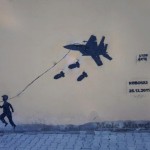Drones over Kurdistan
 I live in Denmark. When I see a drone, it does not scare me because it is on TV. It reminds me of Star Wars. The drone is nothing more but a toy, a movie prop.
I live in Denmark. When I see a drone, it does not scare me because it is on TV. It reminds me of Star Wars. The drone is nothing more but a toy, a movie prop.
My people live in Kurdistan. When they see a drone, it scares them. It reminds them of the Roboskî Massacre in 2011. The drone is more than a flying object; it is a threat, an omen of death.
Roboskî is not an isolated incident. It is a continuation of the threat against the Kurdish people posed by the state of Turkey; a threat they have gotten used to.
The Turkish and US military use war tactics on people who are not even warriors. Officially, drones are used to gather intelligence on the movement of PKK, a Kurdish rebel group considered “terrorists” by Turkey and the US. In reality, drones are terrorizing civilians. With drones flying over their homes and schools, they are isolated from the rest of society, country and world.
They are different because they are droneable.
Kurds who live under the rule of the Turkish government and in villages like Roboskî are a perfect example of droneable people: Many are poor, have little leverage with the people in Turkey and none with the government. They are subjects of a mentality that sees them as inferior. Because why else was it trees that triggered the popular Gezi protests this year and not the Roboskî Massacre? Why was it trees in Istanbul and not decades of oppression, violence, murder, torture and humiliation that caused nationwide protests and captured the world’s attention?
Those are the characteristics of the perfect droneable people.
Upon receiving information from the drone about movement on the southern borders of Turkey, the US intelligence notified Turkish officers who then took matters into their own hands. The military later stated that
Since the area where the group was located was often used by terrorists and a movement towards our border was determined, it was evaluated that the area should be held under fire by air force planes.
Why were two F-16 jets immediately sent to attack? They did not for sure know it was PKK militants crossing the border, they could only assume. Why did they not take the time to find out?
Because even if they were civilians, the Turkish officials knew they would be able to get away with it. They knew because they attacked the land of the droneable people and that is okay.
The Roboskî Massacre happened in December 2011 and while the Turkish authorities were busy avoiding taking responsibility for the killings, Turkey started developing their own drones
The TAI Anka is a family of unmanned aerial vehicles (UAV) developed by Turkish Aerospace Industries for use primarily by the Turkish Air Force. […] Anka has made Turkey the 3rd country in the world that can design and produce MALE UAV’s after USA and Israel.
The name of these drones is according to Wikipedia inspired by a phoenix-like bird called Angha Iranian legends say that this bird purifies the land and waters. It is an eerie coincidence considering the purpose of the drones but knowing Turkey, it might not be a coincidence.
Although some media report that not all the drones purchased by Turkey are working perfectly, Turkey’s interest in drones is worrying for Kurds.
In November 2011, Reuters reported that a US Predator drone mission consisting of four drones was moved from Iraq to an air base in İncirlik, situated on the southern borders of Turkey.
According to a Wikileaks cable this was done on Turkey’s request
In September, the Washington Post reported that Turkey sought deployment of a fleet of US drones in its territory as a measure to be used against the PKK after US withdrawal from Iraq.
On March 29th, 2013 the Turkish General Staff confirmed that the number of unarmed drones at the İncirlik base is four. It also stated that a “Memorandum of Understanding” was signed by Turkey and the US to meet intelligence needs.
John Kirby, a spokesman for Pentagon said that “the United States had a longstanding operation using Predators to help Turkey develop intelligence about the PKK’s activities in northern Iraq.
Turkey has also been purchasing drones from Israel; in 2004 it was 10 Heron drones and in 2008 it was 3 Aerostars.
Drones (surveillance and attacks) have become a common US tactic abroad despite it being illegal – if you see how frequently it is happening in Pakistan, it is because not enough people are condemning and exposing this gross violation.
One can only assume that based on US records this will be a common tactic in Kurdistan too – and we need to continue pushing this story forward to show that we will not allow this to happen without ensuring that the people behind such crimes are held accountable.
Comments
Pingback: Droni sul Kurdistan | Retekurdistan.it
On October 4th 2014,International Protestday against drones, we will highlight the use of drones in Kurdistan and in other places like Pakistan, Jemen.Wwe will protest against Sweden´s training of the big drone nEUROn in the North of Sweden at NEAT-North European Aerospace Testrange- big as Belgium. See http://www.space4peace.org
Agneta Norberg, vice chair,Swedish Peace Council and in the Board of directors in Global Network Against Weapons and Nuclear Power in Space.